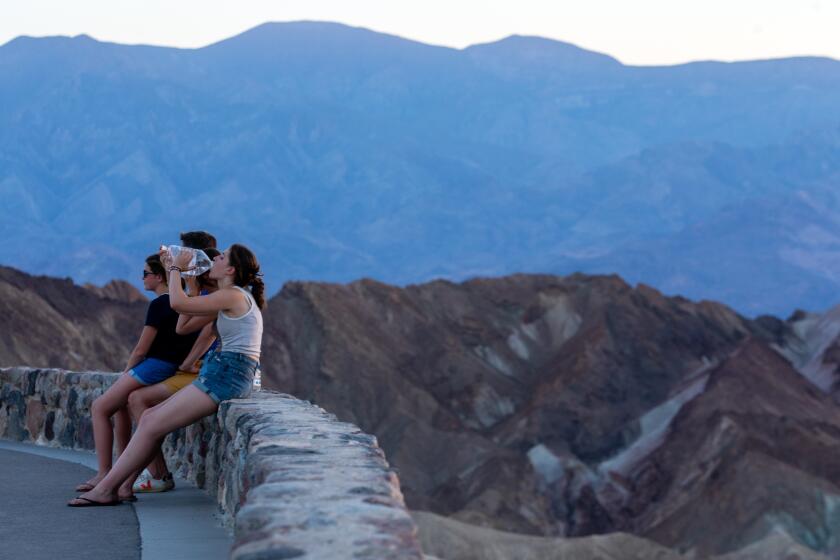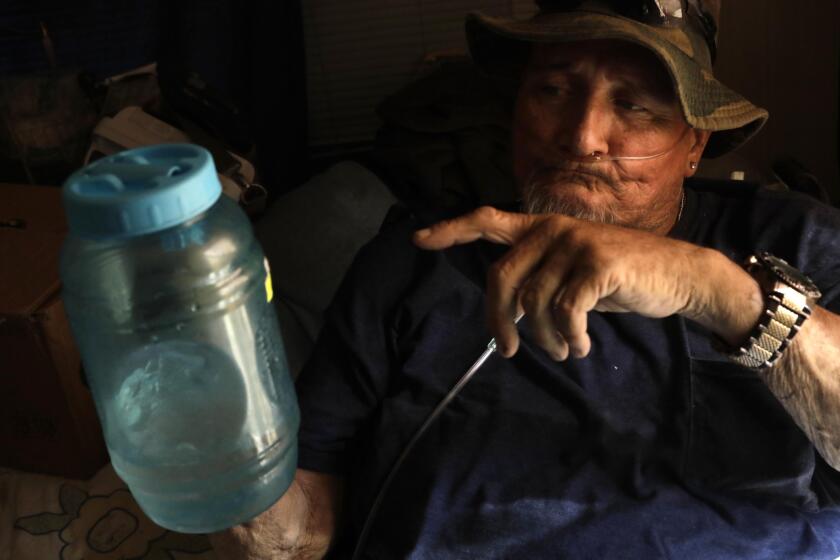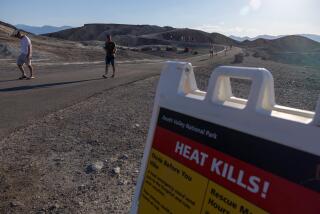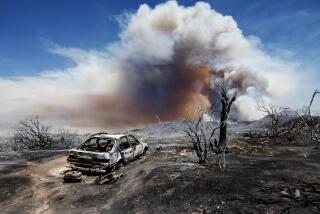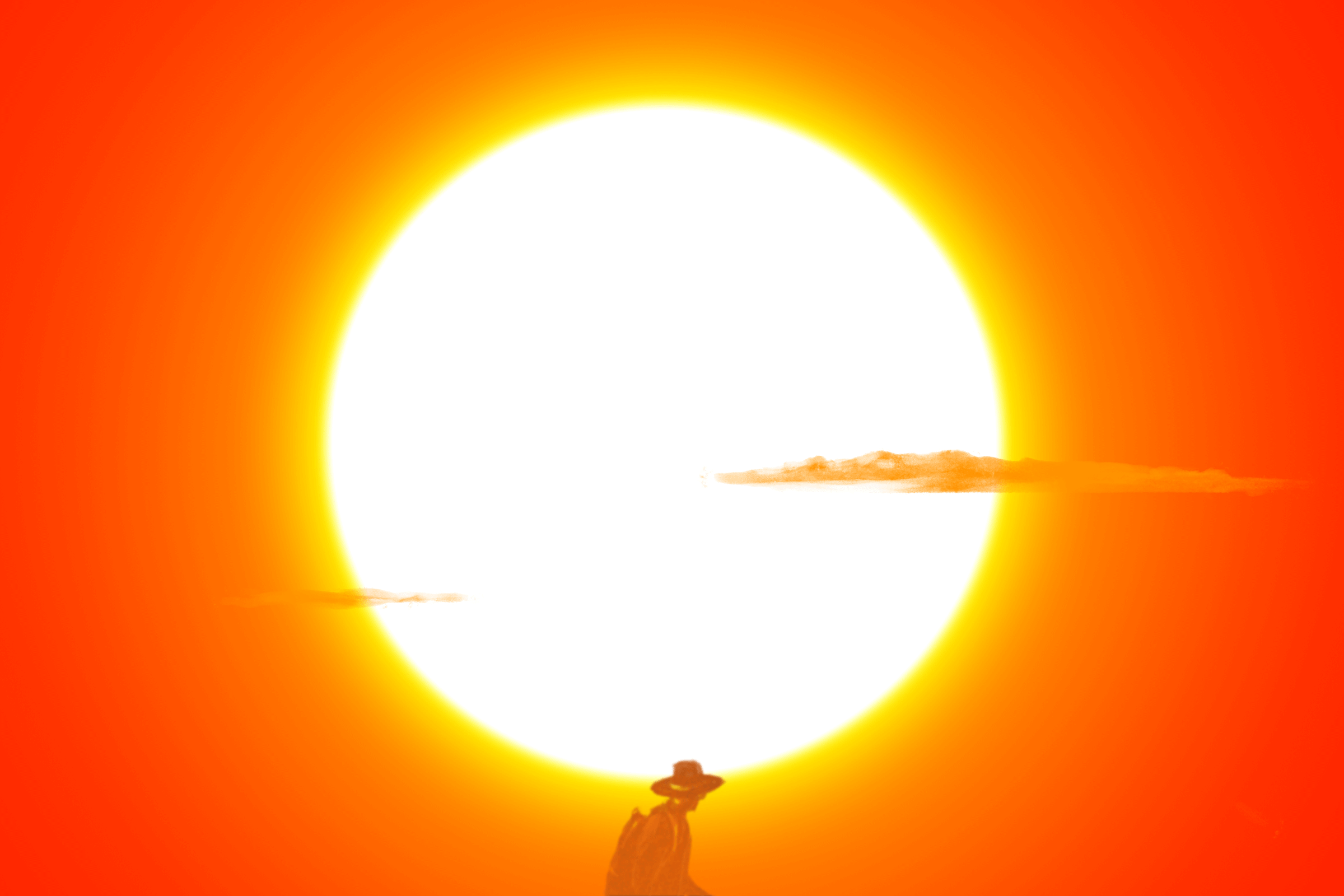
- Share via
As a kid in Miami, I thought I knew heat.
In the mornings before school, the windows of my parents’ house would be fogged with humidity, as if the swamp of South Florida were trying to press its way in.
As an adult in Los Angeles, I thought I knew heat — that sizzling dryness that arrives each summer and fall, curing the grasses and prickling the skin.
But never have I felt anything like Death Valley last week, where the temperature climbed to 128 degrees, within striking distance of the all-time world record the valley set in 1913 — 134 degrees.
It was the kind of heat that burns your eyeballs, that shocks your brain and makes your body feel nauseous and weak.
As a reporter who is often called to the front lines of wildfires, floods and other disasters, this was a different kind of beast, something most people alive have yet to experience.
One park visitor described it as like an open oven; another like a blow dryer to the face. I imagined it was more like the surface of the sun, or like someone had left the lights on in hell.
It was in those circumstances that I met Steve Curry.
Death Valley temperatures soared to 128 degrees Sunday, breaking the daily record of 127 degrees set in 2005 and 1972. It was expected to hit 125 on Monday.
I was interviewing a smattering of intrepid, heat-seeking tourists at Zabriskie Point, a scenic vista overlooking the park’s otherworldly badlands. Although it was just after 10 a.m. on Tuesday morning, the temperature was already well into the triple digits.
Suddenly, my colleague, photojournalist Francine Orr, spotted a lone figure scrambling up a nearby canyon and snapped his photo.

By the time I looked over, the hiker had already reached the blacktop and scrunched his lean frame beneath a metal informational sign — the overlook’s only spot of shade. His face was smeared with white zinc sunscreen; his body clad in khaki against the searing sun.
He was from the Sunland neighborhood of Los Angeles, he told us from beneath his wide-brimmed straw hat. He was 71.
As he sat in his small patch of shade, he laced his gloved fingers over one knee. A one-liter plastic bottle of water, nearly full, rested beside him. It didn’t seem like enough for his trek, and although it was still morning, we were worried for his safety.
The park service advises visitors not to hike in the park after 10 a.m. during extreme summer temperatures, but Steve was chipper. He said he was an experienced outdoorsman, and he was determined to finish his round-trip solo hike to Golden Canyon.
We asked if he wanted water or air conditioning or a ride back to the trailhead, which was about two miles away as the crow flies.
Already, a scalding wind was blowing through the park, overheating our electronic equipment and turning metal door handles into hot irons. Francine and I could bear only a few minutes of it before diving into our cars for the relief of air conditioning, but Steve was persistent. He said he had completed extensive training and was getting ready for another hike in August.
Death Valley, one of the most extreme places on the planet, is already seeing the impact of climate change, with summers even hotter than usual.
What we now know is that Steve did finish his journey, but just barely. He collapsed outside the bathrooms at Golden Canyon at about 3:40 that afternoon and died shortly after. Though the coroner has not yet confirmed his cause of death, officials said they believe it to be heat-related.
His obituary was not the kind of story I ever hoped to write, although it was an honor to pay tribute to Steve, and to learn more about the kind of person he was from his lovely wife, Rima, who is still reeling from her loss.

Steve’s death brought me face to face with the harsh reality of our worsening climate crisis. Because while he may be the first person I have interviewed to succumb to extreme heat, he almost certainly will not be the last.
Experts say that extreme heat is one of the most insidious consequences of humanity’s reliance on fossil fuels, and also one of the most underestimated. Last year, Europe saw more than 60,000 heat deaths. This month, several people passed out on an airplane in Las Vegas as they waited on the tarmac in 111-degree weather. In Phoenix, a toddler suffered second-degree burns after wandering onto hot pavement.
Read all of our coverage about how California is neglecting the climate threat posed by extreme heat.
Most climate scientists will tell you that the numbers on the thermometers are not surprising. For decades, we’ve all known this would happen.
But the speed at which it is happening, and the scale and pace of the suffering, is still hard to grasp, even for those of us who write and think about climate change on a daily basis. Even in a place called Death Valley.
It’s as if all of Earth’s vital signs are blinking code red at once — the oceans are hotter than ever and Arctic ice is depleting at a record pace. Violent weather and killer heat waves are converging, with all signs indicating that 2023 will be among the hottest years we’ve ever seen.
Steve Curry, an experienced and inveterate hiker from Sunland, is believed to be the second person to die in Death Valley’s searing heat this year.
In Death Valley, the beauty and ferocity of our fevered planet were on full display. The evening before I met Steve, I sat in my hotel room eating ice from a bucket like it was a bag of potato chips, trying my best to cool down after a day of reporting left my skin flushed and my thinking slow. More than once that afternoon, I had wondered at what temperature boots melt.
My hope was that sharing his story could be not just a tribute but a public service. A death like Steve’s is not something many people have encountered up close, but I fear that it soon will be.
His wife, Rima, said later that Steve lived for the outdoors — so much so that he would sometimes set up a tent in his own backyard. She took small comfort in knowing that he died doing what he loved to do.
But he also had life yet to live. He was looking forward to seeing “Oppenheimer,” and to more hikes in the future.
“We were supposed to grow old together, sit on our rocking chairs on the porch,” Rima said.
I’ll be haunted by the image of that lost future for a long time. It is seared in my brain, I think, like a new kind of heat.
More to Read
Sign up for Essential California
The most important California stories and recommendations in your inbox every morning.
You may occasionally receive promotional content from the Los Angeles Times.

